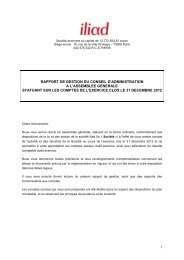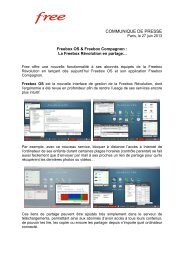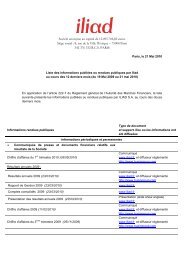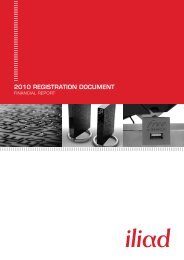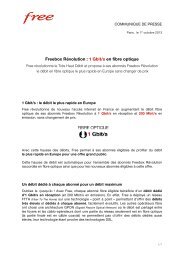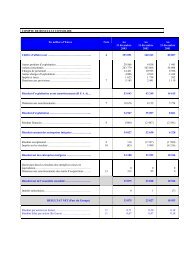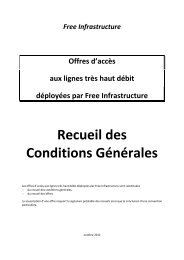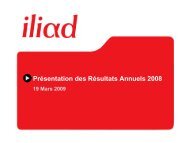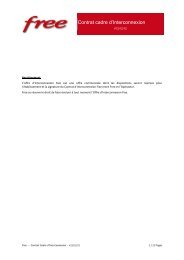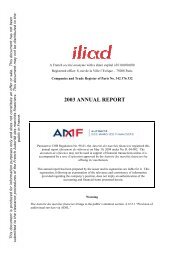REGISTRATION DOCUMENT AND FINANCIAL REPORT - Iliad
REGISTRATION DOCUMENT AND FINANCIAL REPORT - Iliad
REGISTRATION DOCUMENT AND FINANCIAL REPORT - Iliad
- TAGS
- registration
- iliad
- iliad.fr
Create successful ePaper yourself
Turn your PDF publications into a flip-book with our unique Google optimized e-Paper software.
6. OVERVIEW OF THE GROUP’S BUSINESS<br />
6.1 PRINCIPAL ACTIVITIES<br />
The Group has decided to reinforce its peering capabilities in Europe by being present on several new exchange<br />
points.<br />
In particular, the Group has entered into IRU agreements for optic fibers to connect Paris to London, Amsterdam,<br />
Brussels and Frankfurt.<br />
<strong>Iliad</strong> has also reinforced its peering capabilities on the East Coast of the United States, and now boasts two<br />
transatlantic 10-Gigabit connections.<br />
International transit<br />
At December, 31, 2007 for international transit, Free used the services of two transit service providers offering<br />
bandwidth capacity of 40 Gigabits per second: Level3 and Teleglobe.<br />
Server platform<br />
All Free’s servers run on a Linux operating system, which is well-established and used by many Internet-based<br />
companies.<br />
Free’s Linux-based infrastructure consists mainly of Dell 1U PC servers installed at its various PoPs. Free uses<br />
Network Appliance file servers for data storage.<br />
6.1.4 Description of the Group’s principal activities<br />
6.1.4.1 The Broadband segment<br />
6.1.4.1.1 Free<br />
Free is the third largest broadband Internet access provider in France and one of the few such providers to have<br />
become profitable through the provision of ISP services. Free first posted a profit in April 2001, only 24 months<br />
after the start-up of its business.<br />
Today, Free has four different Internet access offerings, characterized by their simplicity, attractive pricing and<br />
recognized technical quality. They also provide tools allowing subscribers to take full advantage of the Internet’s<br />
many features, including portals, search engines, email, personal website construction tools and account<br />
management systems. These four offerings consist of the “Pay-as-you-go” service, the “50-hour plan” and Free’s<br />
broadband and high speed broadband offerings.<br />
Free initially based its growth strategy on the provision of non-subscription access to the Internet<br />
(“Pay-as-you-go” access) offering a limited range of content. Its marketing strategy was based on minimizing<br />
advertising expenditure and emphasized the simplicity and low cost of the offering. This strategy was successful,<br />
with Free now claiming over four million user-created email addresses.<br />
After completing the roll-out of its telecommunications network and interconnecting with the France Télécom<br />
network in April 2001, Free was in a position to control the cost structure of an offering based on Internet<br />
connection time. It therefore launched an attractive and profitable dial-up package, charging a fixed rate of<br />
€14.94 for 50 hours of Internet usage per month. Free has capitalized on the different nuances of its brand name,<br />
transforming it from a name implying that the offering is free of charge into a name associated with high-quality<br />
paid services and the freedom offered to users of these services.<br />
This new brand image was enhanced with the launch in October 2002 of Free’s ADSL broadband offering for<br />
€29.99 per month. Through the use of its network and by building on its experience in dial-up offerings, Free has<br />
developed a high-quality broadband access offering which is attractively priced and, where possible, makes the<br />
most of the opportunities afforded by the unbundling of the local loop.<br />
Free’s offerings are pertinent to all Internet user segments and have different maturity profiles, with some<br />
subscribers migrating from one offering to another (such as from the “Pay-as-you-go” service to the “50-hour<br />
plan” and from the “50-hour plan” to the Free broadband offering). The downturns in the “50-hour plan” offering<br />
and the “Pay-as-you-go” offering are more than offset by strong growth in the broadband offering.<br />
30 - <strong>Iliad</strong> – Registration Document 2007



